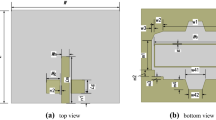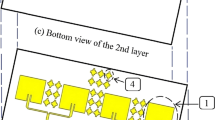Abstract
This paper presents a design of a novel double-layer microstrip antenna, which is feed by coaxial line in back-feed way. The lower-layer element is used as the drive, meantime the upper-layer element the slave. The antenna is analyzed by using high frequency electromagnetic simulation software, HFSS, and fabricated. Good agreement between the simulations and measurements is observed. Good consistency of the fabricated antennas is achieved.
Access provided by Autonomous University of Puebla. Download conference paper PDF
Similar content being viewed by others
Keywords
1 Introduction
Microstrip antenna is a new type of antenna that appeared in the 1970s. Due to its advantages of small size, low profile, light weight and low cost, it has received more and more attention. In recent years, it has been widely used in mobile communication, radar, remote sensing, medical instrumentation and other fields. For a single microstrip patch unit, there are many options for feeding, such as a microstrip line coplanar with the antenna, or a stripline and slot coupling structure. However, the degree of freedom of the feeding position of the microstrip line is not very large; the stripline plus slot coupling structure requires two additional layers of dielectric substrates to complete. In comparison, the method of direct coaxial line back-feed not only increases the flexibility of the feeding position, but also avoids the increase in cost caused by the stripline multilayer dielectric substrate structure. For coaxial back-feed, the upper-layer microstrip patch unit is often used as the driving patch, and the lower-layer patch is used as the parasitic patch, which is mainly for the convenience of welding the coaxial inner conductor and the metal patch. But solder joints will reduce the flatness of the antenna surface. The standing wave ratio bandwidth of traditional microstrip antennas is generally between 0.7% and 7%, which greatly limits the application of microstrip antennas in broadband fields. Therefore, increasing the VSWR bandwidth of microstrip antennas has become a research hotspot. A more typical way to increase the bandwidth is to use a double-layer microstrip patch unit, so that the antenna has two resonance frequency points. Some of the existing researches use the upper-layer patch as the driving patch and the lower-layer patch as the parasitic patch [1]; or although the lower-layer patch is the driver, the multi-layer dielectric boards are first welded and then overlapped, resulting in a consistent performance decrease [2,3,4], or there is only a simulation model, and no real objects are processed [5, 6].
In view of this technical defect, this paper adopts the coaxial line back feed method, and the lower layer patch is the driving patch, that is, the coaxial line is used to excite the lower layer patch, and the upper layer patch is used as the parasitic patch. Double-layer patch integrated processing, making welding reserved holes on the upper dielectric substrate. According to this idea, the high-frequency electromagnetic simulation software HFSS is used to model and simulate, and the real object is processed. The simulation results show that the bandwidth with a standing wave ratio better than 1.3 is close to 9%. The measured results are basically consistent with the simulation results, and the processed antennas have good consistency.
2 Antenna Structure Design
The top view of the antenna is shown in Fig. 1, and the overall size is 50 × 35 mm. A two-layer dielectric substrate is used, the plate is Rogers 5880, the relative dielectric constant is 2.2, and the thickness of the two-layer dielectric substrate is 2 mm.
The upper layer patch is 19.55 × 19.55 mm square and is etched on the upper layer dielectric substrate; the lower layer patch is 19.95 × 19.95 mm square and is etched on the lower layer dielectric substrate. The upper and lower dielectric substrates are fixed together by a prepreg. There are 4 reserved holes for screws around. According to the cavity mode theory, the radiation of the microstrip antenna is generated by the equivalent magnetic current around the cavity. Therefore, digging a small circle in the middle of the H surface of the upper patch will not have a significant impact on the antenna radiation. Therefore, a through hole with a diameter of 3 mm can be opened at the corresponding feeding position of the upper dielectric substrate and reserved for welding, that is, the reserved welding hole in Fig. 1. The feeding position is shown in Fig. 1, and the coaxial inner conductor is soldered to the lower patch. Since the solder joints are in the reserved holes for soldering, the flatness of the antenna surface is guaranteed.
3 Simulation and Measured Results
The actual photo is shown in Fig. 2. Figure 3 shows the simulated and measured VSWR. In Fig. 3, the solid line is the test curve, the dotted line is the simulation curve of the upper dielectric substrate with through holes, and the dotted line is the simulation curve of the upper dielectric substrate without through holes.
As can be seen from Fig. 3, the dashed and dotted lines have similar trends, indicating that the presence or absence of vias does not affect the antenna too much. There is an obvious dual-frequency resonance phenomenon in the simulation, as shown by the dotted line in Fig. 3, the resonance frequency points are f0−100 MHz and f0+150 MHz respectively, making the working frequency band with a standing wave ratio better than 1.3 reach close to 9%. However, the measured results show that only the low frequency point, that is, the resonance of the lower patch is relatively obvious, as shown by the solid line in Fig. 3. There may be two reasons for the analysis. On the one hand, there is a certain processing error in the upper patch, and on the other hand, the dielectric constant of the prepreg is slightly higher than the parameter setting in the simulation, which eventually causes the high frequency resonance frequency to shift to the low frequency. Therefore, from the measured results, the two resonant frequency points are too close, and the effect of broadening the VSWR bandwidth is not obvious.
The three curves in Fig. 4 are the standing wave ratio diagrams of the three actual antennas measured respectively. It can be seen that the antennas designed and processed by this method have good consistency.
Figure 5 shows the simulated and measured E-plane patterns at the center frequency. It can be seen that the simulation results are basically consistent with the measured results.
Figure 6 shows the measured E-plane pattern in the working frequency band. The energy distribution of the E surface in the frequency band is very stable.
Figure 7 shows the simulated and measured H-plane patterns of the center frequency. It can be seen that the measured results are roughly consistent with the simulation results, but in the direction deviating from the zenith ±25°, the direction map appears slightly concave. The reason for the analysis is that the ground boundary condition is set as an ideal conductive surface during simulation, but in actual processing, a 50 × 35 × 5 mm hard aluminum block is used as the metal ground. The H-plane diffracts the surface wave in a limited way, which in turn causes the pattern to be recessed at a specific angle. The ground of the E-plane is asymmetric with respect to the antenna, and the ground is larger in the direction of theta >90°. Therefore, as shown in Fig. 6, the E-plane direction map is biased towards theta >90°.
Figure 8 shows the measured H-plane pattern in the working frequency band. The H-plane energy distribution in the frequency band is stable.
4 Conclusion
In this paper, a new type of double-layer microstrip antenna is designed and processed, which adopts the coaxial back-feeding method. The lower microstrip patch is the driving patch, and the upper microstrip patch is the parasitic patch. Under the premise of not affecting the radiation mechanism, the project realizes the direct welding of the lower microstrip patch and the coaxial joint. The measured results of the standing wave ratio and the pattern are basically consistent with the simulation results, which further verifies the feasibility of this new idea. The new double-layer microstrip antenna has the advantages of low cost and no need to add a multi-layer dielectric substrate for feeding; the surface has good flatness due to no solder joints; the processing consistency is good, and it is suitable for use as a phased array antenna unit.
References
Chen, B., Liang, C.: Research on single-fed dual-frequency double-layer microstrip microstrip antenna with large frequency difference. Space Electron. Technol. (1) (2008)
Xiangzhen, S.: Research on circularly polarized double layer microstrip antenna. J. Telemetry Track. Comm. 5, 6 (2004)
Tung-Hung, H.: Double-layer high-gain microstrip array antenna. IEEE Trans. Antennas Prop. (2000)
Zhang, Y., Liu, C., Guo, C., Li, T.: Design and analysis of a circular double-layer broadband microstrip antenna. In: 2011 Cross Strait Quad-Regional Radio Science and Wireless Technology Conference (2011)
Yu, X., He, J., Fang, X., Pan, G.: Computer simulation design of double-layer wideband microstrip antenna. In: 2010 2nd International Conference on Mechanical and Electronics Engineering (2010)
Pi, W.C., Choon, S.L.: Planar double-layer leaky-wave microstrip antenna. IEEE Trans. Antennas Prop. (2002)
Author information
Authors and Affiliations
Corresponding author
Editor information
Editors and Affiliations
Rights and permissions
Copyright information
© 2023 The Author(s), under exclusive license to Springer Nature Singapore Pte Ltd.
About this paper
Cite this paper
Zhao, P., Wang, D., Wu, M., Ning, X., Li, X., Ma, J. (2023). A Novel Back-Feed Double-Layer Microstrip Antenna. In: Wang, Y., Liu, Y., Zou, J., Huo, M. (eds) Signal and Information Processing, Networking and Computers. ICSINC 2022. Lecture Notes in Electrical Engineering, vol 996. Springer, Singapore. https://doi.org/10.1007/978-981-19-9968-0_6
Download citation
DOI: https://doi.org/10.1007/978-981-19-9968-0_6
Published:
Publisher Name: Springer, Singapore
Print ISBN: 978-981-19-9967-3
Online ISBN: 978-981-19-9968-0
eBook Packages: Computer ScienceComputer Science (R0)












